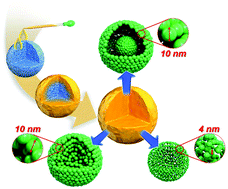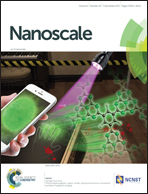A new general approach to synthesizing filled and yolk–shell structured metal oxide microspheres by applying a carbonaceous template†
Abstract
New mechanisms were found for the formation of metal oxide microspheres with yolk–shell and filled structures by applying carbonaceous template microspheres with high porosity. Repeated impregnation first adopted to achieve a high loading rate of metal precursor in the carbonaceous template provided the breakthrough. The carbonaceous template with an appropriate loading rate of the metal precursor produced metal oxide microspheres with filled and yolk–shell structure depending on the ramping rate and oxygen concentration during the post-treatment process. Combustion of the carbonaceous template—which occurs during the moderate post-treatment process in air with a high oxygen concentration—must occur to form yolk–shell structured microspheres. On the other hand, the decomposition of carbon by post-treatment at a slow ramping rate in an atmosphere with a low oxygen concentration without burning produced filled-structured metal oxide microspheres. The carbonaceous template with a high loading rate of the metal precursor produced metal oxide microspheres with filled structures even at a fast ramping rate and high oxygen concentration during the post-treatment process. The new strategy was applied to synthesize various metal oxide microspheres including SnO2, Fe2O3, NiO, and Mn2O3 microspheres.



 Please wait while we load your content...
Please wait while we load your content...